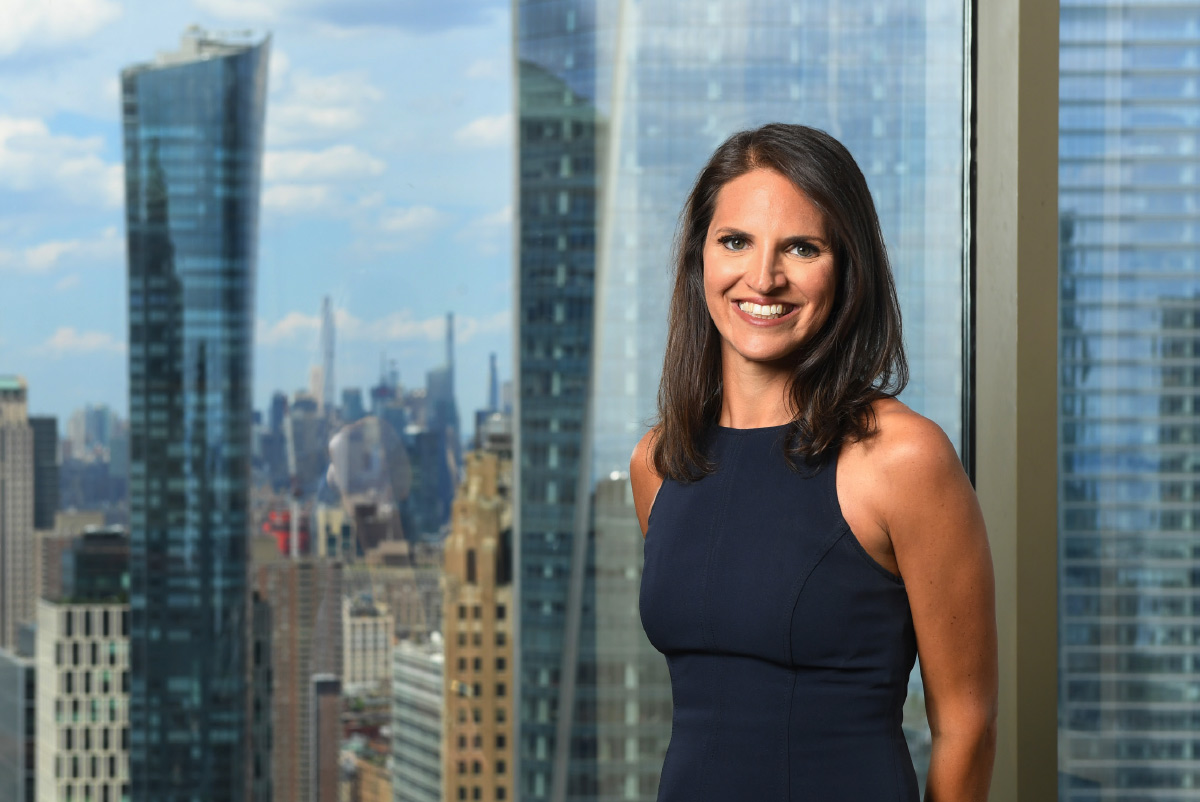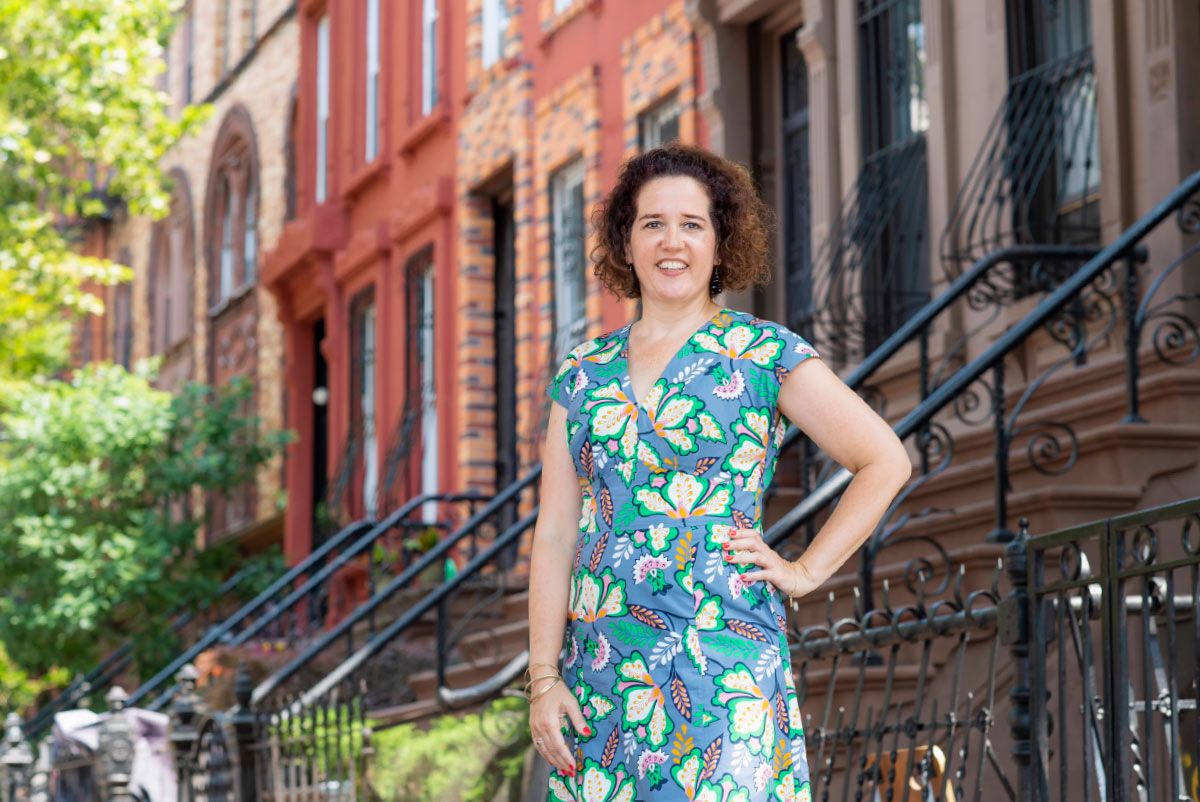Reset, Rebuild, Reinvent
The Future of Our Town
rom her 36th-floor office window, Bonnie Neuman ’06 can see the life trickling back into New York City. The dark days of the early pandemic are a fading memory, her young son is back at school, and work is “crazy busy” again. Neuman heads Cadwalader, Wickersham & Taft’s real estate finance division in lower Manhattan, where she can see the tourists heading to the Freedom Tower or over to Battery Park to hop on the ferry to the Statue of Liberty and Ellis Island. Their return to New York City means a return to normalcy for the hotel and hospitality sector that makes up a good part of her real estate finance business.
Reset, Rebuild, Reinvent

The Future of Our Town
rom her 36th-floor office window, Bonnie Neuman ’06 can see the life trickling back into New York City. The dark days of the early pandemic are a fading memory, her young son is back at school, and work is “crazy busy” again. Neuman heads Cadwalader, Wickersham & Taft’s real estate finance division in lower Manhattan, where she can see the tourists heading to the Freedom Tower or over to Battery Park to hop on the ferry to the Statue of Liberty and Ellis Island. Their return to New York City means a return to normalcy for the hotel and hospitality sector that makes up a good part of her real estate finance business.
A City of Transformation
“The changing real estate market is a challenge, especially for Class B and C office buildings in Manhattan,” said Foye. “That’s a reality, and it will affect everything from city tax revenues, to the coffee guy outside the building, to Broadway shows, to everything in between.” In the April survey, 80% of companies said they would use a hybrid model of work, compared with 6% before the pandemic.
Nestor Davidson, the Albert A. Walsh Professor of Real Estate, Land Use, and Property Law and faculty director of the Urban Law Center at Fordham Law, said the city is going through a major transformation but points out it is one of many it has undergone over the centuries. “The truth is, we, as a global city, have reinvented ourselves over and over and over again,” he said. At its founding, the city’s raison d’etre was its port, “the fulcrum point between Europe, the Caribbean, and the American interior,” according to Davidson. Its next incarnation was as the country’s largest manufacturing hub. When that ended, artists and other members of the creative class moved into the empty factory lofts. After 9/11, unused space in the Financial District was also repurposed for residential use, and a neighborhood that was once empty on weekends was suddenly full of young families pushing strollers.
“The bones are really good,” said Davidson of New York’s buildings. “But it’s not like you just slap a kitchen in and you’re done. It takes some planning. There are some aspects of New York City that will look very different over the next generation.”
As of June 2022, the vacancy rate for office buildings is at 13%, up from 7.8% before the pandemic, according to CommercialEdge. “What do you do with that empty space?” asked Neuman. “Is there a creative use for repurposing office or hotel spaces? There are lots of different things on the table right now. … People have been creative in the past and will be creative again. But I don’t expect there will be a lot of empty space for long.”

On the Market
Foye credits the housing market’s strength to the constant influx of young talent across all fields, particularly tech, finance, fashion, AI, and social media. “Landlords are pretty good at squeezing rent out of 25-year-olds coming to the big city for the first time,” said Foye. “So, rental markets are robust.”
Unfortunately, New York City’s growth does not benefit everyone. Rents in general not only returned to their pre-pandemic rates last year but surpassed them, leaving behind those who can’t afford high- to moderate-income apartments. According to Apartment List, New York City rents rose 33 percent between January 2021 and January 2022. The rent moratorium put in place during the pandemic by then New York governor Andrew Cuomo was rolled back at the start of 2022, triggering a wave of evictions. Even rent-stabilized apartments are facing rent increases of up to 6% this summer, but only after public pressure forced the city’s Rent Guidelines Board—which determines the increases and whose members are appointed by the mayor—to walk back rent hikes of up to 9%. As a result, the city is facing one of the worst affordable housing crises in its history. “So many people want to be in this incredible, vibrant place, and we’re not building enough [housing] for them,” said Davidson. “If somebody asked me what’s the one intervention that needs to be made in the next 10, 15 years, it is figuring out in a particularly nuanced and careful way how to allow people to live affordably in this city.”

Fighting for Home
“Right now, gentrification is intensely aggressive,” said Jessica Rose ’01, executive director of Brooklyn Legal Services Corporation A, who is working to stop the flood of evictions across the city and help preserve neighborhoods. “There’s always generational change and a shift in demographics, but there doesn’t have to be a large-scale displacement of an existing population for progress to occur. It’s becoming a transient city.”
Even for those who remain in gentrified neighborhoods, it is very difficult to survive, said Rose. “If you’re lucky enough to win one of the few lotteries for the affordable housing that’s being produced, you look around and groceries have become gourmet, organic supermarkets have replaced your old deli. All of the amenities you need to live in a neighborhood scale up in terms of price point.”
Though the problems of the city compound one another, the solutions can also have a domino effect. “Keeping people in their homes and having more affordable housing, more solutions for people who are unhoused, real mental health services, education, access to technology—these things are all connected,” said Leah Horowitz ’06, Fordham Law’s assistant dean for public interest and social justice initiatives. “When you address one, it affects all the other problems.”

“A few years ago, [eviction defense/prevention work] wasn’t on the radar for students,” said Horowitz. When students tell her they want to be involved in social justice issues like civil rights, racial justice, and women’s rights, she advises them that housing is the one area that intersects with all the problems people face in the city. “Women in poor communities of color disproportionately face eviction,” she said. “If you want to do social justice work, this is it.”

“People are like, ‘Oh, great, Brooklyn is now a great place to get a cup of coffee,’” said Singh. “We need to reassess the image that is put out with the word ‘gentrification.’ People are going to lose their homes. People are going to go out of business.”
In early May 2022, Mayor Eric Adams included an additional $5 billion for affordable housing production in the city budget. Yet critics say the funds are not nearly enough to address the post-COVID housing crisis.
“It’s something people don’t want to talk about, but it’s right there in front of their eyes,” said Singh. “People are moving out right down the street from you. People in my building have no heat and hot water.” Despite the severity of the issues, Singh feels encouraged by the work of tenant organizers and tenant unions across the city, which have been laying the groundwork for progress for decades. “I’m hoping more people are paying attention and getting involved.”
While new housing laws such as New York state’s 2019 Housing Stability and Tenant Protection Act and the City Council’s 2014 Right to Counsel law make strides in helping low-income tenants stay in their homes, advocates say the services provided don’t go far enough. Currently, households qualify for free legal representation under the new law only if their household income falls 200 percent below the federal poverty line. (For example, a family of three would need to be making under $44,000 a year to qualify.) Members of the Right to Counsel NYC Coalition, who fought for the law, argue that the threshold should be lowered to give more access to those in need.
Now that the city’s moratorium on eviction has been lifted, housing courts have been backed up with cases, and more lawyers are needed to address the growing number of evictions. Rose said that it seems the city is seeing about 7,000 new cases a month since January 2022. “We believe the city has contracted with legal services programs to represent roughly 35,000 cases, but there is a backlog of cases … of at least approximately 75,000, based on the information we have heard and seen on the ground. We are all trying to understand the true reality of the situation, but it seems clear there are significantly more cases in housing court than what has been contracted for by the city with legal service providers.”
The Need for Leadership
Davidson sees the lull in regional train ridership as an opportunity to be seized. He proposes a regional approach to solving the city’s housing crisis, including building apartments in Westchester County and Long Island. “The Long Island Rail Road doesn’t have enough people on its trains right now,” he said. “We are at a moment of great opportunity, where the usual arguments against development ring hollow in terms of the infrastructure. We need to be thinking of planning and zoning as well as development and preservation problems. They’re not easy questions. We need to solve the supply problem and we need to preserve communities. You can do both—it just takes real leadership.”

Tom Allon, founder of the political media outlet City & State, is bringing together city officials and faculty at Fordham, NYU, and Hunter College to come up with solutions to the city’s problems, including its empty office and hotel buildings. The Five Borough Institute, a nonprofit think tank launched by Allon in May 2022, is taking concrete steps to address problems quickly. As part of a pilot program, Allon plans on using two buildings—one in the Financial District and one in Midtown—for a micro-study on how office buildings can be retrofitted. He said empty hotels in the outer boroughs can be converted into housing if trade councils and unions agree to the proposal and government subsidies are provided. Hybrids, with partial office space and partial residential space, would also be a great draw for young workers.
“That’s the future of Midtown and of Downtown: taking these buildings and making them a mix,” said Allon. “As difficult and complicated as it’s going to be to retrofit commercial real estate, it’s going to be less complicated than building from scratch.” He points to the transformation of the Financial District after 9/11—which saw the number of residents in the neighborhood rise from 10,000 to 70,000—as proof. “There is a road map and a history here. So let’s roll up our sleeves. We have a historic opportunity to take something that’s a negative and make it a positive.”
Davidson cautioned that the changes that came after 9/11 are no guarantee that a similar plan will work this time around, but he believes cooperation and time could lead to meaningful change. “Will the city survive? Will the city thrive? Will the city transform itself? Past performance is no guarantee of future success, as lawyers like to say. But I’m optimistic. What we need is all hands on deck.”